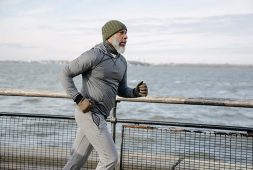Wearable Device Can Take Ultrasound Images Of Muscles During Exercise, Providing Better Diagnosis And Treatment

A groundbreaking wearable ultrasound system developed by a bioengineer at George Mason University has the potential to revolutionize the way musculoskeletal injuries are diagnosed and monitored.
This innovative technology aims to provide real-time information about muscle tissues during physical activities, offering immediate insights into whether a twinge or tweak experienced during rehabilitation is related to a muscular or skeletal injury.
Musculoskeletal injuries affect millions of individuals annually, and the recovery journey is often arduous and prolonged. The conventional approach to assessing a patient’s progress involves medical professional conducting a series of tasks and exercises during slow rehabilitation. However, the dynamic nature of these exercises poses a challenge in obtaining a clear, real-time understanding of muscle function.
Moreover, the post-rehabilitation period introduces a unique set of challenges. Even when individuals no longer experience pain or discomfort, they may still be hesitant to trust the movements that initially led to their injury..
Addressing these concerns, Parag Chitnis and his team at George Mason University have developed a wearable ultrasound system that can provide clinically relevant information about muscle function during dynamic physical activity.
Chitnis said, “For instance, when an individual is performing a specific exercise for rehabilitation, our devices can be used to ensure that the target muscle is actually being activated and used correctly.”
“Other applications include providing athletes with insights into their physical fitness and performance, assessing and guiding recovery of motor function in stroke patients, and assessing balance and stability in elderly populations during routine everyday tasks,” he adds.
What sets this wearable ultrasound system apart is its ability to move with the patient, offering an unprecedented level of insight into body dynamics. Unlike many medical technologies that provide insights into the inner workings of the body but are impractical during movement, Chitnis’s monitor allows for continuous monitoring while the patient is on the go.
“Traditionally, ultrasound systems transmit short-duration pulses, and the echo signals are used to make clinically useful images. Our systems use a patented approach that relies on transmission of long-duration chirps, which allows us to perform ultrasound sensing using the same components one might find in their car radio,” Chitnis explained.
Creating a wearable ultrasound device required a comprehensive reinvention of ultrasound technology. Chitnis and his team went back to the drawing board, developing a modified approach that resulted in a simpler and more cost-effective system.
This innovation enabled the creation of a miniaturized, battery-powered ultrasound monitor with a small, portable form factor that can be easily attached to a patient.
The implications of this technology are vast, particularly in the realm of sports medicine, physical therapy, and general healthcare. The ability to monitor muscle function in real time during various activities could significantly enhance the accuracy of diagnostics and inform tailored rehabilitation programs.
Looking ahead, Chitnis envision further improvements to the wearable ultrasound system. His goal is to develop software tools that can quickly interpret and analyze ultrasound signals, streamlining the diagnostic process. This promising technology was presented at the Acoustics 2023 event, which took place at the International Convention Centre Sydney.
By providing real-time information during dynamic physical activity, it has the potential to transform the way healthcare professionals approach the assessment and rehabilitation of musculoskeletal injuries.
As technology continues to advance, innovations like these hold the promise of improving patient outcomes and expediting the recovery process for millions of individuals worldwide.



